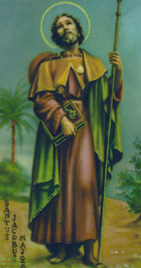
SAINT JAMES - APOSTLE OF JESUS CHRIST
Saint James and his brother John, who later became Saint
John the Evangelist, were born in Galilee. They were the sons of Zebedee and
they made their living as fishermen. Their story is indeed well known to
Christians. One day while mending their nets with Zebedee, they were called by
Jesus to follow him. They left their father and their livelihood and, with Peter
and his brother Andrew whom Jesus had promised to make "fishers of men", they
became his first disciples. James and John were possessors of a somewhat
impetuous nature and on occasions, a fiery temper. For this reason Jesus gave
them the surname Boanerges "the sons of thunder". James was with Jesus at the
cure of Peterís mother-in-law and the raising of the daughter of Jairus from the
dead. He was one of the three disciples, with Peter and John, who witnessed the
Transfiguration and also one set to watch in the Garden of Gethsemane.

It is not known for certain where James preached and carried the message after the Ascension as no account survives from the writers of the early days of the Church. However, there is a continuing tradition in Spain that he made an evangelising visit to the country but the first account only appears in an oriental document in the seventh century. James was the first apostle to die for the Faith. He was executed on the orders of King Herod Agrippa in AD 44 during a persecution of Christians carried out in order to placate the Jews at Passover. He was buried as one might expect in Jerusalem but as with many early saints not destined to remain there. There is a very strong belief that his relics were transported to Spain, to Santiago in Galicia in northern Spain.
This tradition dates from the middle of the ninth century and in the Middle Ages a fine cathedral was constructed to house his relics. This place became one of the most important shrines in Western Europe and the focus of a pilgrimage which is still undertaken today. During the Middle Ages, several Augustinian and Cluniac houses were established along the pilgrim routes to accomodate the large numbers of Christians anxious to visit the shrine of Saint James. Even in England, religious establishments profited from a connection with the saint. Reading Abbey was believed to have the alleged hand of James and this was to bring them considerable benefit. There are 414 churches dedicated to Saint James in this country.
The pilgrimage was so popular that images of the saint bear the pilgrimís hat and the scallop shell which are both associated with Compostella.
His feast day falls on the 25th July and the cult that grew up around his relics was based on his reputation as the powerful defender of Christianity against the Moors. Today he is remembered as one of Christís most beloved apostles and for the pilgrimage to Santiago de Compostela. In 2001, the Rev John Wall, a minister from the north east, undertook the pilgrimage by bicycle. He, as many before him, travelled El Camino (the Pilgrim Road). In an article in the Methodist Recorder (reprinted in the Summer 2001 edition of our magazine) he describes his journey. He tells how he travelled through France from St Malo and crossed the Pyrenees, joining the Pilgrim Road at St Jean Pierre Pied de Port. Here he collected his pilgrimís passport which enabled him to stay at the "refugios" along the way. He was impressed by the faith and tenacity of his fellow pilgrims and overwhelmed by the warmth and hospitality of the Spanish people who made no attempt to make money from the pilgrims as they passed through villages and small towns. He shares his excitement and delight on arriving at the Mate de Gozo (the Mount of Joy) and then seeing the great cathedral and finally attending the Mass. The broadcaster and lapsed Catholic Brian Sewell also walked the Pilgrim Road and he too, was moved and overwhelmed by the faith of many of his fellow pilgrims and by the beauty of the Mass in the cathedral at journeyís end.
As to the doubts concerning Saint Jamesí translation from Jerusalem to Santiago, the relics are still there and in 1884 in a Papal Bull issued by Leo XIII, they were declared authentic. John Wall writes that it intrigues him "how Saint James ever got to Spain and that all the legends seem to contradict the evidence of the New Testament". However, he goes on to say that he "could disprove nothing and it was "better to travel accepting rather than doubting". A maxim for all pilgrims? Yes, indeed!
Barbara Hothersall